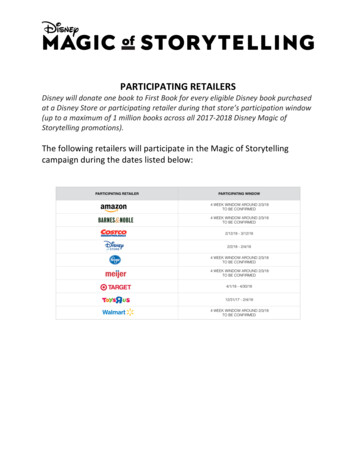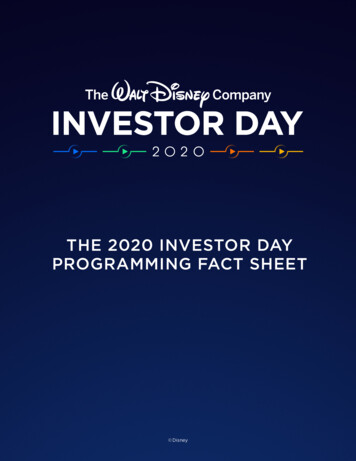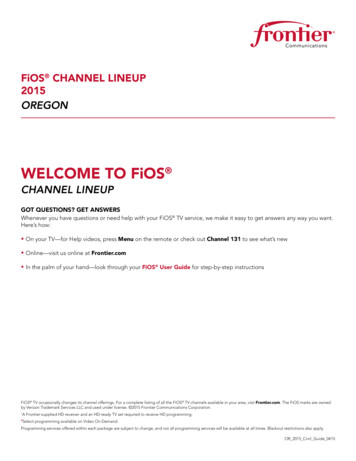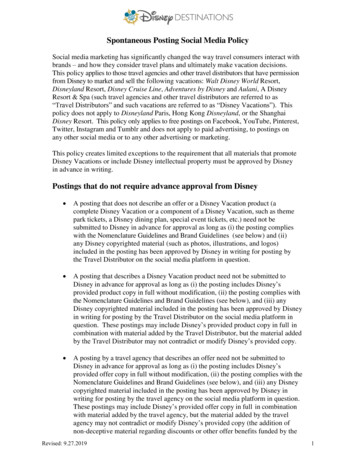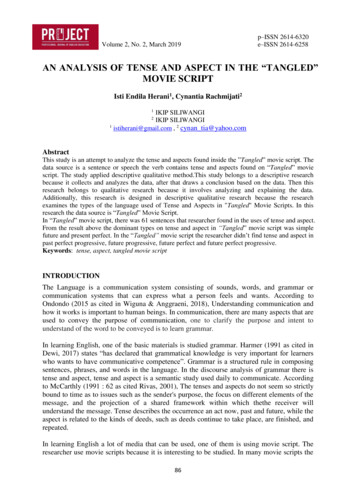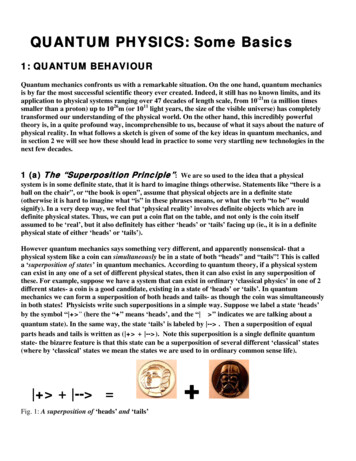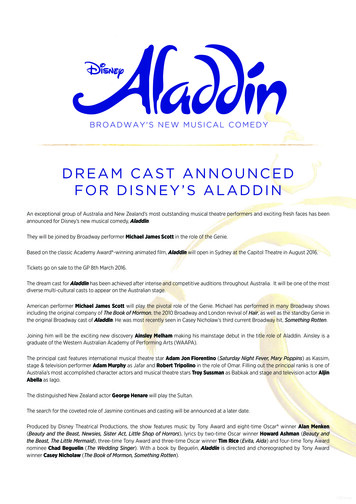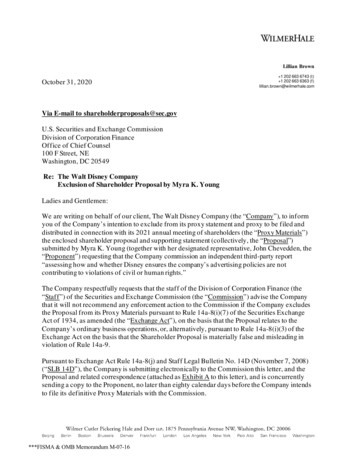
Transcription
WILMERHALELillian Brown 1 202 663 6743 (t) 1 202 663 6363 (f)lillian.brown@wilmerhale.comOctober 31, 2020Via E-mail to shareholderproposals@sec.govU.S. Securities and Exchange CommissionDivision of Corporation FinanceOffice of Chief Counsel100 F Street, NEWashington, DC 20549Re: The Walt Disney CompanyExclusion of Shareholder Proposal by Myra K. YoungLadies and Gentlemen:We are writing on behalf of our client, The Walt Disney Company (the “Company”), to informyou of the Company’s intention to exclude from its proxy statement and proxy to be filed anddistributed in connection with its 2021 annual meeting of shareholders (the “Proxy Materials”)the enclosed shareholder proposal and supporting statement (collectively, the “Proposal”)submitted by Myra K. Young (together with her designated representative, John Chevedden, the“Proponent”) requesting that the Company commission an independent third-party report“assessing how and whether Disney ensures the company’s advertising policies are notcontributing to violations of civil or human rights.”The Company respectfully requests that the staff of the Division of Corporation Finance (the“Staff”) of the Securities and Exchange Commission (the “Commission”) advise the Companythat it will not recommend any enforcement action to the Commission if the Company excludesthe Proposal from its Proxy Materials pursuant to Rule 14a-8(i)(7) of the Securities ExchangeAct of 1934, as amended (the “Exchange Act”), on the basis that the Proposal relates to theCompany’s ordinary business operations, or, alternatively, pursuant to Rule 14a-8(i)(3) of theExchange Act on the basis that the Shareholder Proposal is materially false and misleading inviolation of Rule 14a-9.Pursuant to Exchange Act Rule 14a-8(j) and Staff Legal Bulletin No. 14D (November 7, 2008)(“SLB 14D”), the Company is submitting electronically to the Commission this letter, and theProposal and related correspondence (attached as Exhibit A to this letter), and is concurrentlysending a copy to the Proponent, no later than eighty calendar days before the Company intendsto file its definitive Proxy Materials with the Commission.Wilmer Cutler Pickering Hale and DorrBeijingBerlinBostonBrusselsDenver***FISMA & OMB Memorandum M-07-16LLP,Frankfurt1875 Pennsylvania Avenue NW, Washington, DC 20006LondonLos AngelesNew YorkPalo AltoSan FranciscoWashington
WILMERHALEOctober 31, 2020Page 2BackgroundOn September 11, 2020, the Company received the Proposal from the Proponent, which states asfollows:Proposal [*]: Advertising Policies and Social MediaWhereas, Shareholders are concerned that Disney faces reputational and businessrisk for contributing to the spread of racism, hate speech, and disinformationonline through its advertising on social media platforms like Facebook, YouTubeand Twitter.Social media platforms face criticism for failing to protect the civil and humanrights of billions of people. In 2019, Chief Executive Officer Bob Iger said:“ we all know that social news feeds can contain more fiction than fact,propagating vile ideology that has no place in a civil society that values humanlife.” 1Disney’s values are described in standards for advertising by third parties onDisney’s sites, which require advertising not contain “false or misleading claims,”“unlawful, harmful, threatening, defamatory, obscene” content, nor“Discrimination based on race, sex, religion, nationality, disability, sexualorientation or age.” 2Yet, Disney advertises on platforms where similar standards are often notenforced. Facebook has been widely criticized for permitting harmful content andhas settled civil rights lawsuits claiming Facebook excluded people from seeinghousing, employment and credit ads based on age, gender and race.3 In 2019,Disney ads on YouTube appeared beside content associated with a “soft-corepedophilia ring,” 4 and a Google executive admitted Google might never be able toguarantee “100% safety” for brands on er-be-100-brand-safe12
WILMERHALEOctober 31, 2020Page 3One study found 80% of Americans would reduce or stop buying a product ifadvertised next to extreme or dangerous content online6. From January to June2020, Disney was Facebook’s top U.S. advertiser, spending 210 million.7 In2018, Disney advertising accounted for 4% of YouTube revenue.8Shareholders question whether Disney’s social media advertising policies embodythe company’s values, including its commitment to racial justice. Disney recentlyrestated its commitment to diversity and inclusion and pledged 5 million to civilrights organizations. Executive Bob Chapek said: “ it is critical that we doeverything in our power to ensure that acts of racism and violence are nevertolerated.”Media reports recently found some advertisers seeking to avoid controversy wereno longer placing ads adjacent to content about COVID-19, Black Lives Matter,and other prominent news issues.9 As a top digital advertiser, Disney isresponsible for societal and business impact when it enables the spread of hatespeech and disinformation, or demonetization of content in the public interest.Resolved, shareholders request the Board of Directors commission anindependent third-party report, at reasonable cost and omitting proprietaryinformation, assessing how and whether Disney ensures the company’sadvertising policies are not contributing to violations of civil or human rights.Among other things, such report should consider whether advertising policiescontribute to the spread of hate speech, disinformation, white supremacistrecruitment efforts, or voter suppression efforts, and whether the policiesundermine efforts to defend civil and human rights such as through thedemonetization of content that seeks to advance and promote such r-disney-cuts-ad-spending-wsjsays#: :text xchange-blocking-articles-about-racism.html6
WILMERHALEOctober 31, 2020Page 4Basis for ExclusionThe Proposal May Be Excluded Pursuant to Rule 14a-8(i)(7)Rule 14a-8(i)(7) permits a company to exclude a shareholder proposal if the proposal “deals witha matter relating to the company’s ordinary business operations.” The underlying policy of theordinary business exclusion is “to confine the resolution of ordinary business problems tomanagement and the board of directors, since it is impracticable for shareholders to decide howto solve such problems at an annual shareholders meeting.” SEC Release No. 34-40018 (May21, 1998) (the “1998 Release”). As set out in the 1998 Release, there are two “centralconsiderations” underlying the ordinary business exclusion. One consideration is that “[c]ertaintasks are so fundamental to management’s ability to run a company on a day-to-day basis thatthey could not, as a practical matter, be subject to direct shareholder oversight.” The otherconsideration is that a proposal should not “seek[] to ‘micro-manage’ the company by probingtoo deeply into matters of a complex nature upon which shareholders, as a group, would not bein a position to make an informed judgment.” The Proposal implicates the first of theseconsiderations.The Proposal May Be Excluded Because the Subject Matter of the Proposal DirectlyConcerns the Company’s Ordinary Business OperationsThe Proposal may be excluded in reliance on Rule 14a-8(i)(7) because it relates to the manner inwhich the Company advertises its products and services. The Staff consistently has concurredthat decisions regarding a company’s advertising of products and services relate to a company’sordinary business operations and thus may be excluded under Rule 14a-8(i)(7). For example, inAmazon.com, Inc. (March 23, 2018), the Staff concurred in exclusion of a proposal requestingthat “the board take the steps necessary to establish a policy that will ensure that the Companydoes not place promotional or other marketing material on online sites or platforms that produceand disseminate content that expresses hatred or intolerance for people on the basis of actual orperceived race, ethnicity, national origin, religious affiliation, sex, gender, gender identity, sexualorientation, age or disability” as relating to the Company’s ordinary business operations. In thisregard, the Staff noted that the Proposal “relates to the manner in which the Company advertisesits products and services.” See also Ford Motor Company (February 2, 2017) (concurring inexclusion of a proposal requesting that the company assess the political activity resulting from itsadvertising and any resulting exposure to risk because the proposal related to Ford’s ordinarybusiness operations); FedEx Corp. (July 11, 2014) (concurring in exclusion of a proposal relatingto the company’s sponsorship of the Washington DC NFL franchise team given controversy overthe team’s name because the proposal “relate[d] to the manner in which FedEx advertise[d] itsproducts and services”); Tootsie Roll Industries Inc. (January 31, 2002) (concurring in exclusion
WILMERI-IALEOctober 31, 2020Page 5of a proposal asking the company to identify and disassociate from any offensive imagery to theAmerican Indian community in product marketing and advertising because the proposal relatedto “the manner in which a company advertises its products”); The Quaker Oats Company (March16, 1999) (concurring in exclusion of a proposal requesting the formation of an employeecommittee to review advertising for content slandering people based on race, ethnicity, orreligion because the proposal related to “the manner in which a company advertises itsproducts”); PepsiCo, Inc. (February 23, 1998) (concurring in exclusion of a proposal requestingthat the Board of Directors prepare a report regarding the use of nonracist portrayals by thecompany because the proposal related to “the manner in which a company advertises itsproducts”); and General Mills, Inc. (July 14, 1992) (concurring in exclusion of a proposal toestablish a policy of not advertising on Geraldo Rivera’s show and other “trash TV” programsbecause the proposal related to “the manner in which a company advertises its products”).The allocation of advertising resources to best promote a company’s products and services is akey management function. As a diversified worldwide entertainment company, the Company’sinternal and external advertising professionals devote significant time, energy and resources inmaking decisions relating to the advertising of the Company’s products and services, includingdetermining the appropriate channels for advertising, such as social media platforms. Further,the Company operates in a highly competitive industry and marketing effectiveness is among thecompetitive factors that affect the sales of its products and services. By requesting a report onthe assessment of “how and whether Disney ensures the company’s advertising policies are notcontributing to violations of civil or human rights,” the Proposal reflects the Proponent’s attemptto impose on the Company the Proponent’s own views on advertising strategy and standards.However, as in the precedents discussed above, the manner or context in which a companyadvertises its products address ordinary business issues, and thus are excludable under Rule 14a8(i)(7).To the extent that the Proponent might argue that a request for a report to shareholders regardingan assessment of whether the Company’s advertising policies are contributing to civil or humanrights violations is not the same as dictating advertising, the Staff has rejected similar attempts toput form over substance. Framing a shareholder proposal in the form of a request for a reportdoes not change the underlying nature of the proposal. The SEC has long held that the Staffevaluates proposals requesting dissemination of a report by considering the underlying subjectmatter of the proposal when applying Rule 14a-8(i)(7), and that such proposals are excludablewhen the substance is within the ordinary business of the company. See Release No. 34-20091(August 16, 1983) (“[T]he staff will consider whether the subject matter of the special report orthe committee involves a matter of ordinary business; where it does, the proposal will beexcludable”). See also Rite Aid Corp. (April 17, 2018) (concurring in exclusion of a proposalrequesting a report on the feasibility of adopting company-wide goals for increasing energy
WILMERI-IALEOctober 31, 2020Page 6efficiency and use of renewable energy, in which the Staff determined that the proposal focused“primarily on matters relating to the Company’s ordinary business operations”); and Netflix, Inc.(March 14, 2016) (concurring in exclusion of a proposal that requested a report relating to thecompany’s assessment and screening of “inaccurate portrayals of Native Americans, AmericanIndians and other indigenous peoples,” in which the Staff determined that the proposal related tothe ordinary business matter of the “nature, presentation and content of programming and filmproduction”). Accordingly, even though the Proposal is in the form of a request for a report, it isexcludable because the underlying subject matter bears on the ordinary business topic of themanner in which the Company advertises its products.The Proposal Does Not Raise a Significant Social Policy Issue That Transcends theCompany’s Ordinary Business OperationsThe Proponent seeks to cast the Proposal as relating to a significant policy issue by asserting thatthe Company’s decision to advertise on certain social media platforms “contribute[s] to thespread of racism, hate speech, and disinformation online”; however, the mere reference to asignificant policy issue does not alter the fundamentally ordinary business focus of the Proposalwith regard to the Company in particular.As set out in the 1998 Release, proposals “focusing on sufficiently significant social policyissues (e.g., significant discrimination matters) generally would not be considered to beexcludable [under Rule 14a-8(i)(7)], because the proposals would transcend the day-to-daybusiness matters and raise policy issues so significant that it would be appropriate for ashareholder vote.” As the Staff has since made clear, the extent to which a proposal has a nexusto the business of the company is relevant in assessing whether a proposal may be excluded onthe basis that it relates to the ordinary business of the company notwithstanding a reference to asignificant policy issue. The Staff indicated in Staff Legal Bulletin 14E (October 27, 2009) thata shareholder proposal focusing on a significant policy issue “generally will not be excludableunder Rule 14a-8(i)(7) as long as a sufficient nexus exists between the nature of the proposal andthe company.” In Staff Legal Bulletin 14H (October 22, 2015) the Staff further explained that“[w]hether the significant policy exception applies depends, in part, on the connection betweenthe significant policy issue and the company’s business operations.” Finally, in Staff LegalBulletin 14K (October 16, 2019), the Staff reiterated its view that the applicability of thesignificant policy exception “depends, in part, on the connection between the significant policyissue and the company’s business operations.” The Staff also clarified that the focus of thisanalysis is not on “the overall significance of the policy issue raised by the proposal,” but ratheron “whether the proposal raises a policy issue that transcends the particular company’s ordinarybusiness operations.” Thus, “a policy issue that is significant to one company may not besignificant to another.”
WILMERI-IALEOctober 31, 2020Page 7Consistent with this position, when a proposal does not have a sufficient nexus to a company’sbusiness, the Staff has concurred that the proposal is excludable under Rule 14-8(i)(7) even if ittouches upon a significant policy issue. For example, in PayPal Holdings Inc. (March 6, 2018),the Staff concurred in exclusion of a proposal addressing climate change that was submitted to atechnology and digital payment company and in Viacom Inc. (December 18, 2015), the Staffconcurred in exclusion of a proposal requesting that the company issue a report assessing thecompany’s policy responses to public concerns regarding linkages of food and beverageadvertising to impacts on children’s health, despite the proponent’s assertion that the company,by virtue of licensing popular characters to manufacturers of certain food products, was in aposition similar to the food manufacturers. See also Amazon.com, Inc. (discussed above); WalMart Stores, Inc. (March 9, 2011) (concurring in exclusion of a proposal addressing gun violencethat was submitted to a multiproduct retailer); and Rite Aid Corp. (March 5, 1997) (concurring inexclusion of a proposal regarding the health effects of cigarette smoking that was submitted to amultiproduct retailer). In comparison, in AmerisourceBergen Corp. (January 11, 2018) the Staffdeclined to concur in exclusion of a proposal addressing the opioid crisis that was submitted to apharmaceutical products distributor engaged in the distribution of opioids.Here, and as in the letters cited above, to the extent the Proposal references a significant policyissue generally, it does not raise a significant policy issue as to the Company because it does nothave a sufficient nexus to the business of the Company. The business of the Company isentertainment, not hosting and/or creation of content on a social media platform. Accordingly,the Proposal is excludable as related to the Company’s ordinary business pursuant to Rule 14a(8)(i)(7).The Proposal May Be Excluded Pursuant to Rule 14a-8(i)(3)Rule 14a-8(i)(3) permits a company to exclude all or portions of a shareholder proposal “[i]f theproposal or supporting statement is contrary to any of the Commission’s proxy rules, includingRule 14a-9, which prohibits materially false or misleading statements in proxy solicitingmaterials.” Specifically, Rule 14a-9 provides that no solicitation may be made by means of anyproxy materials “containing any statement which, at the time and in the light of thecircumstances under which it is made, is false or misleading with respect to any material fact, orwhich omits to state any material fact necessary in order to make the statements therein not falseor misleading or necessary to correct any statement in any earlier communication with respect tothe solicitation of a proxy for the same meeting or subject matter which has become false ormisleading.” The Note to Rule 14a-9 provides examples of statements that may be misleadingwithin the meaning of Rule 14a-9, including “Material which directly or indirectly impugnscharacter, integrity or personal reputation, or directly or indirectly makes charges concerningimproper, illegal or immoral conduct or associations, without factual foundation.” This point is
WILMERHALEOctober 31, 2020Page 8reiterated in Staff Legal Bulletin No. 14B (September 15, 2004) (“SLB 14B”), which states that“reliance on rule 14a-8(i)(3) to exclude or modify a statement may be appropriate where statements directly or indirectly impugn character, integrity or personal reputation, or directly orindirectly makes charges concerning improper, illegal or immoral conduct or associations,without factual foundation.” In addition, the Staff takes the view that a proposal may beexcluded pursuant to Rule 14a-8(i)(3) where “neither the stockholders voting on the proposal,nor the company in implementing the proposal (if adopted), would be able to determine with anyreasonable certainty exactly what actions or measures the proposal requires” and where “thecompany demonstrates objectively that a factual statement is materially false or misleading.”SLB 14B.The Staff has previously concurred in the exclusion of shareholder proposals pursuant to Rule14a-8(i)(3) in cases where the proposals contained statements that were “materially false ormisleading.” See, e.g., Ferro Corporation (March 17, 2015) (concurring in exclusion of aproposal requesting that the company reincorporate in Delaware based on misstatements of Ohiolaw, which suggested that the stockholders would have increased rights if the Delaware lawgoverned the company instead of Ohio law); General Electric Co. (January 6, 2009) (concurringin exclusion of a proposal regarding director service on board committees as false andmisleading where the proposal repeatedly referred to “withheld” votes and incorrectly impliedthat the company offered shareholders the ability to withhold votes in elections of directors); andJohnson & Johnson (January 31, 2007) (concurring in exclusion of a proposal as materially falseor misleading where the proposal involved an advisory vote to approve the company’scompensation committee report but contained misleading implications about the contents of thereport in light of SEC disclosure requirements).The Proposal is materially false and misleading in several respects. Notably, the Proposal statesthat “[i]n 2019, Disney ads on YouTube appeared beside content associated with a ‘soft-corepedophilia ring.’” We do not know what this statement is based upon. The Proponent does notprovide any factual foundation for this inflammatory statement, which impugns the character,integrity and reputation of the Company and makes a charge concerning improper and immoralassociations. Rather, the Proponent cites to online materials that are not publicly available andwhich neither the Company nor its stockholders would be able to access to assess the veracity ofthe Proponent’s inflammatory statement. Without such information, stockholders do not havethe information needed to make an informed voting decision.In footnote 2 the Proponent references a website address which, as of the date of this letter,cannot be found, a screen shot of which is attached hereto as Exhibit B. In Staff Legal BulletinNo. 14 (July 13, 2001) (“SLB 14”), the Staff included the following interpretive guidance:
WILMERHALEOctober 31, 2020Page 9May a reference to a website address in the proposal or supporting statement besubject to exclusion under the rule?Yes. In some circumstances, we may concur in a company’s view that it may exclude awebsite address under rule 14a-8(i)(3) because information contained on the website maybe materially false or misleading, irrelevant to the subject matter of the proposal orotherwise in contravention of the proxy rules. Companies seeking to exclude a websiteaddress under rule 14a-8(i)(3) should specifically indicate why they believe informationcontained on the particular website is materially false or misleading, irrelevant to thesubject matter of the proposal or otherwise in contravention of the proxy rules.The Staff expanded on its approach to website links in Staff Legal Bulletin 14G (October 16,2012) (“SLB 14G”), reiterating that website references may be excludable under Rule 14a8(i)(3) and noting that “if a proposal references a website that is not operational at the time theproposal is submitted, it will be impossible for a company or the [S]taff to evaluate whether thewebsite reference may be excluded.” Specifically, the Staff stated that it considers “only theinformation contained in the proposal and supporting statement and determine[s] whether, basedon that information, shareholders and the company can determine what actions the proposalseeks.” Further, “[i]f a proposal or supporting statement refers to a website that providesinformation necessary for shareholders and the company to understand with reasonable certaintyexactly what actions or measures the proposal requires, and such information is not alsocontained in the proposal or in the supporting statement, then we believe the proposal wouldraise concerns under Rule 14a-9 and would be subject to exclusion under Rule 14a-8(i)(3) asvague and indefinite.” Without the information included in the link, the Company’s stockholderswill not be able to make an informed voting decision. In addition, as the Staff noted in SLB14G, “a reference to a non-operational website in a proposal or supporting statement could beexcluded under Rule 14a-8(i)(3) as irrelevant to the subject matter of a proposal.”As discussed above, the Proponent has not provided any factual basis for the inflammatorystatement impugning the character, integrity and reputation of the Company and chargingimproper and immoral associations relating to the location of Disney ads on YouTube nearinappropriate content, while also citing to online materials that are not available for the Companyand its stockholders to evaluate. Accordingly the Proposal is materially false and misleading inviolation of Rule 14a-9 and therefore may be excluded in its entirety under Rule 14a-8(i)(3),consistent with SLB 14 (the Staff may “find it appropriate for [the Company] to exclude theentire proposal, supporting statement, or both, as materially false or misleading.”).
WILMERHALEOctober 31, 2020Page 10ConclusionFor the foregoing reasons, and consistent with the Staff’s prior no-action letters, we respectfullyrequest that the Staff concur that it will take no action if the Company excludes the Proposalfrom its Proxy Materials pursuant to Rule 14a-8(i)(7), on the basis that the Proposal relates to theCompany’s ordinary business operations, or, alternatively, Rule 14a-8(i)(3), on the basis that theProposal is materially false and misleading in violation of Rule 14a-9.If the Staff has any questions with respect to the foregoing, or if for any reason the Staff does notagree that the Company may exclude the Proposal from its Proxy Materials, please do nothesitate to contact me at lillian.brown@wilmerhale.com or (202) 663-6743. In addition, shouldthe Proponent choose to submit any response or other correspondence to the Commission, werequest that the Proponent concurrently submit that response or other correspondence to theCompany, as required pursuant to Rule 14a-8(k) and SLB 14D, and copy the undersigned.Best regards,Lillian BrownEnclosurescc:Jolene Negre, Associate General Counsel and Assistant SecretaryThe Walt Disney CompanyJohn Chevedden
EXHIBIT A
Mr. Alan N. BravermanCorporate SecretaryThe Walt Disney Company (DIS)500 S Buena Vista StreetBurbank CA 91521Dear Mr. Braverman:amIdelighted to own shares in The Walt Disney Company. However, I believe the Board shouldtake this opportunity to signal improvement in its corporate governance.My attached proposal requesting a report on Advertising Policies and Social Media is for the nextannual shareholder meeting. I w ill meet Rule 14a-8 requirements, including the continuousownership of the required stock value until after the date of the respective shareholder mee1ting.My submitted format, with the shareholder-supplied emphasis, is intended to be used for definitiveproxy publication .This is my delegation to John Chevedden and/or his designee to forward this Rule 14a-8 proposalto the company and to act as my agent regarding this Rule 14a-8 proposal , negotiations and/ormodification, and presentation of it for the forthcoming shareholder meeting.Please direct all future communications regarding my rule 14a-8 proposal to John Chevedden***to facilitate prompt and verifiable communications. Please identify me exclusively as the lead filerof the proposal.This letter does not cover proposals that are not rule 14a-8 proposals. This letter does not fJrantthe power to vote. Your consideration and the consideration of the Board of Directors isappreciated in support of the long-term performance of our company. Please acknowledge***receipt of my proposal promptly by email to. We look forward tonegotiations and implementation.SincerelySeptember 11 , 2020Date
[DIS: Rule 14a-8 Proposal, September 11, 2020][This line and any line above it - Not for publication.]Proposal r]: Advertising Policies and Social MediaWhereas, Shareholders are concerned that Disney faces reputational and business risk for contributing to the spread ofracism, hate speech, and disinformation online through its advertising on social media platforms like Facebook,You Tube and Twitter.Social media platforms face criticism for failing to protect the civil and human rights of billions of people. In 2019, ChiefExecutive Officer Bob lger said: ".we all know that social news feeds can contain more fiction than fact, propagating vileideology that has no place in a civil society that values human life."'Disney's values are described in standards for advertising by third parties on Disney's sites, which require advertisingnot contain "false or misleading claims," "unlawful, harmful, threatening, defamatory, obscene" content. nor"Discrimination based on race, sex. religion. nationality, disability, sexual orientation or age."2Yet, Disney advertises on platforms where similar standards are often not enforced. Facebook has been widelycriticized for permitting harmful content and has settled civil rights lawsuits claiming Facebook excluded people fromseeing housing, employment and credit ads based on age, gender and race. 3 In 2019, Disney ads on YouTube appearedbeside content associated with a "soft-core pedophilia ring," and a Google executive admitted G
2020, Disney was Facebook ’s top U.S. advertiser, spending 210 million. 7. In 2018, Disney advertising accounted for 4% of YouTube revenue. 8. Shareholders question whether Disney ’s social media advertisin g policies embody the company’s value s, including its commi
